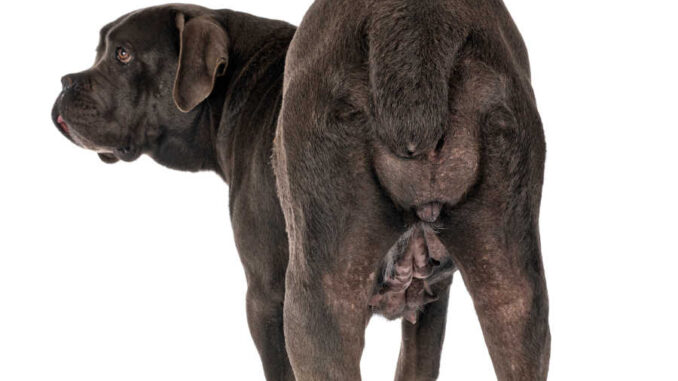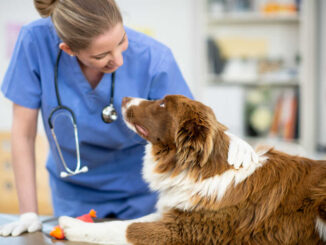
This article was updated on January 22nd, 2024
Female dogs are specially equipped with a self-cleaning system of mucous that helps keep the parts of the reproductive tract healthy and free of germs and irritations. This system may create a clear or white colored discharge. In this article, our veterinarian Dr. Chryle Bonk and vet tech Kate Howard discuss when you should worry, and what you can do at home to help your dog.
Key highlights:
– White discharge in female dogs can be normal but can also indicate illnesses like infections, hormonal imbalances, and trauma
– Call your vet if white discharge appears with other symptoms like blood, behavior changes, vomiting, and diarrhea
– Monitor white discharge and seek vet care if it changes color, is foul smelling, or thick
– Ensuring proper hygiene and keeping the genital area clean might help your dog feel more comfortable
5 things you should know about white discharge in female dogs
While it’s possible for white vaginal discharge in female dogs to be normal, it may also be a sign of illness. Let’s review what you should know about white discharge in female dogs so you can make an informed decision about what to do.
1. White discharge is part of normal bodily functions
Both spayed and intact dogs may normally show some white discharge. It’s just part of normal bodily functions at work to clear out germs and irritants from the vagina and other reproductive parts.
In spayed dogs, this white discharge should be small in amount and may be rarely seen if dogs are diligent about keeping their genital areas clean.
A white discharge can also be normal in intact female dogs during certain stages of their reproductive cycle:
– During heat (estrus): female dogs may have a clear to slightly milky white discharge, which is considered normal. This discharge helps to facilitate the mating process and may turn pink or reddish during heat. See this picture for an example.
– During pregnancy: in pregnant females, you may also notice a clear to white or white-ish discharge that shows up about halfway through gestation and continues until whelping. For more information check out our veterinarian article: Vaginal Discharge in a Pregnant Dog.
“These normal causes of white discharge in female dogs are typically NOT accompanied by any other concerning signs. If the discharge appears abnormal or is accompanied by any other signs of illness or discomfort, it is best to consult with your veterinarian.”
2. Thick, foul-smelling, yellow, or green discharge is cause for concern
While a white discharge can be normal during heat or pregnancy, it is important to be aware of any changes in color, consistency, or odor. If the discharge becomes:
- thick,
- foul-smelling, or
- changes in color (e.g., yellow, green),
it may indicate an infection or other health issue. Additionally, if you notice any changes in your dog’s appetite/thirst, activity, or behavior, there is cause for concern.
White discharge, too, can sometimes indicate a bigger medical issue if you notice any of these symptoms:
- Redness or swelling of the genital area
- Excessive licking of the genital area
- Increased urination or difficulty urinating
- Blood in the urine
- Lethargy or loss of appetite
- Changes in behavior or temperament
- Vomiting or diarrhea
- Foul odor from the discharge
- Pain or discomfort during urination or defecation
- Abdominal pain or bloating
3. Here are eight common medical reasons for white discharge in female dogs
While seeing white discharge in a female dog can be considered normal, there are many common medical reasons for its occurrence:
1. Vaginal infection
Infections such as bacterial vaginosis or yeast infections can cause white or off-white discharge accompanied by odor or irritation. Dogs will usually be uncomfortable, lick excessively, and may urinate more frequently.
2. Pyometra
This serious condition is characterized by a pus-filled uterus and can cause white or pus-like (purulent) discharge, along with other symptoms like fever, lethargy and abdominal pain. This is an emergency and should be seen by a vet immediately.
3. Urinary tract infection (UTI)
UTIs can lead to abnormal discharge, including white or cloudy urine along with frequent urination, straining, and excessive licking. Learn more about UTIs in female dogs.
4. Hormonal imbalances
Hormonal imbalances, such as an overproduction of progesterone, can result in white discharge. Dogs may also have behavior changes, weight loss or weight gain and changes in haircoat.
5. Foreign bodies
Objects lodged in the vaginal canal can cause irritation and discharge as well as discomfort.
6. Allergies or irritation
Allergies or irritants can lead to inflammation and discharge in the genital area.
7. Trauma or injury
Trauma to the genital area can cause discharge.
8. Cancer
In rare cases, certain types of cancer, such as vaginal or uterine cancer, can cause white discharge. Dogs may also be lethargic, have changes in appetite, or abdominal pain.
4. You can monitor white discharge at home and seek vet help if it persists
Dr. Bonk explains when it might be ok to monitor the situation at home (after checking with your vet):
“If the white discharge is mild and your dog appears to be otherwise healthy, it may be acceptable to monitor the situation closely for a short period of time (a couple of days is the maximum recommended). However, it is crucial to keep a close eye on your dog’s symptoms and overall well-being. If the discharge worsens, persists for more than a few days, or is accompanied by any concerning symptoms, it is recommended to seek veterinary advice promptly.”
5. Some home remedies may help your dog feel more comfortable
While home remedies won’t address the underlying medical cause if there is one, they can help alleviate discomfort or support your dog’s overall health. Note that these options are not a substitute for veterinary care. Some options include:
- Keeping the genital area clean by gently wiping with a warm damp cloth.
- Using dog-safe wipes or topical products recommended by your veterinarian.
- Providing your dog with a comfortable and clean environment (be sure to remove any soiled bedding materials and provide fresh clean bedding in it’s place).
- Ensuring proper hygiene and regular bathing as recommended by your veterinarian.
“There are no medications or treatments recommended for at-home intervention without a veterinarian’s input, since the cause of discharge is difficult to pinpoint and treat effectively without professional evaluation.”
Treatment for white discharge depends on the cause, but can include antibiotics, surgery, and supportive care
When you visit your veterinarian, they will perform a thorough examination of your dog, focusing on the genital area. They may collect a sample of the discharge for laboratory analysis, such as a cytology or bacterial culture, to identify the underlying cause. Additional diagnostic tests, such as blood work or imaging, may be recommended based on the initial findings. A comprehensive evaluation will help your veterinarian determine the cause of the white discharge and develop an appropriate treatment plan to address your dog’s condition.
Treatment for white discharge in female dogs will depend on the cause and may include antibiotics, supportive care, or even surgery.
“It is always best to consult with your veterinarian for an accurate diagnosis and appropriate treatment options when dealing with a white discharge in your female dog. Prompt veterinary care can help ensure the health and well-being of your furry companion.”
Related posts:
Disclaimer: This website's content is not a substitute for veterinary care. Always consult with your veterinarian for healthcare decisions. Read More.










Be the first to comment